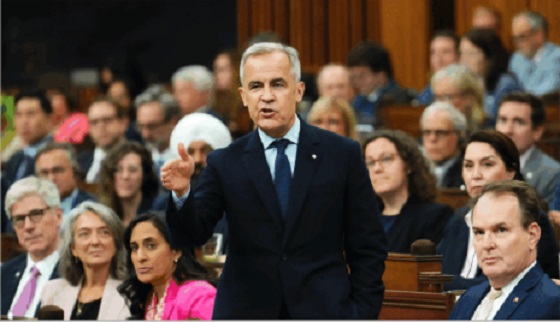Crime
Why is Trump threatening Canada? The situation is far worse than you think!

From LifeSiteNews
By Frank Wright
Multiple reports are proving that Donald Trump’s claims that Canada’s lax approach to fentanyl poses a grave threat is even worse than the U.S. president has stated.
(LifeSiteNews) — A report from the Dana Cambole Show gives a sensational explanation on why U.S. President Donald Trump seems to have Canada in his sights. Her guest on the ITM Trading Channel is the Canadian investigative journalist Samuel Cooper, who says: “Canada has become a node of Chinese infiltration and organized crime activity – especially in Vancouver.”
His bold claim buttresses the accusations made by Trump that the U.S. faces a crisis on its northern border. On February 1, Trump issued an executive order titled, “Imposing Duties to Arrest the Flow of Illicit Drugs Across Our Northern Border”
In it, Trump said his measures to impose punishing trade tariffs were to address the “challenges” presented by the “Gang members, smugglers, human traffickers, and illicit drugs of all kinds [which] have poured across our borders and into our communities.”
He said the Canadian government had failed in its duty to address these issues.
“Canada has played a central role in these challenges, including by failing to devote sufficient attention and resources or meaningfully coordinate with United States law enforcement partners to effectively stem the tide of illicit drugs.”
Is Trump ‘invading’ Canada?
These bold claims have been interpreted as a means of dictating to – or even “annexing” Canada. This has “soured relations” with Canadians, as the Chinese Toronto-based journalist Kevin Jiang reports.
Some critics argue Trump is not serious about fentanyl or crime, and is simply undermining Canadian sovereignty and even threatening to “invade” Canada.
So, is what Trump says about Canada’s crime and border problem true?
Canada has become a Chinese drug production hub
Cooper says it is. After “ten years researching” he has written a book arguing that Chinese Communist party officials, businessmen and drug traffickers have “established a production hub in Canada.”
Called “Wilful blindness: how a network of narcos tycoons and CCP agents have infiltrated the West,” its cover illustrates what Cooper sees as the center of a network of Chinese corruption and crime.
“The cover shows a graphic photo of Vancouver on a world map with fentanyl pills exploding out of Vancouver going around the world.”
“Vancouver has become a production hub for China and a trans-shipment hub for fentanyl precursors.”
Cooper says that whilst he is “not pleased with Donald Trump’s rhetoric,” he maintains, “This gets to what Donald Trump is saying.”
“It’s hard for many people to believe that Canada could be put in the same category as Mexico in terms of endangering the United States with fentanyl, illegal immigration and human trafficking,” Cooper says, before adding “…but my research has showed that indeed this is the fear and concern of the U.S. intelligence Community, military and law enforcement.”
Decades of Canadian weakness
How has this happened? Cooper says the problem has been brewing for years.
“For decades Canada’s weak enforcement against transnational crime weak, and control of borders has allowed international organized crime with linkages to hostile States – most specifically China but also Iran.”
His claims seem astonishing, and yet recent news reports all support his – and Trump’s – conclusions.
The biggest fentanyl superlab in the world
The top story on the Vancouver Sun today is the discovery of the biggest fentanyl factory in Canadian history. The owner, who is Canadian, did not name the tenants who used his property to build “Canada’s largest ever fentanyl superlab.”
“The Abbotsford man who owns the Falkland property where Canada’s largest-ever fentanyl superlab was discovered in October says he was just the landlord and unaware of what was going on there.”
David Asher, senior fellow at the Hudson Institute, said it was in fact the largest fentanyl production site in the world, and was certainly linked to “Chinese organized crime.”
Speaking to Rosemary Barton on the Canadian Broadcasting Corporation, Asher explained on February 9, “I think they are sitting on a big scandal here. How many other labs do you think they have going?”
Largest fentanyl lab ever discovered (superlab) busted in Vancouver. Chinese organized crime likely or Iran. Unreal, 100 million doses shipped South to NW US on ships through our ports that have no law enforcement… pic.twitter.com/hd7251emYm
— Special Situations 🌐 Research Newsletter (Jay) (@SpecialSitsNews) February 10, 2025
Asher, who has advised the U.S. State department on countering money laundering and terrorism financing, claimed “there’s very little border enforcement going on” in Canada, dismissing claims by the Canadian media that Canada’s cross-border drug trafficking into the U.S. was insignificant compared to that of Mexican cartels on the U.S. southern border.
Asher further claims that Mexican cartels are in fact transporting drugs by ship to Canada to be trafficked into the U.S., because “you have almost no port enforcement with police.”
In response to allegations made by the Trump administration that there is a security crisis on the northern border of the U.S., Canada has appointed a “fentanyl Czar,” promised to share more intelligence with the U.S., and said it is stepping up police checks and border controls.
These measures led to the 30 day “pause” of the threatened tariffs on Canadian trade with the U.S.
Canadian law is ‘crazy’
So what’s the U.S. government’s problem with Canada?
Asher praises the federal Royal Canadian Mounted Police (RCMP) but says the problem is Canadian law. Specifically, “The Stinchcombe Law” – a landmark ruling which Asher says means the Canadian police have to inform criminals they are watching them.
“Basically every time we try to go up on a phone number in Canada almost all the money laundering network is tied to China – and 90% percent of all the money laundering in the United States is tied to Canada.”
“So when we try to go up on those numbers with your police they have to inform the person that we are targeting that we are targeting their number. That’s crazy. How can we run an undercover police operation with your country?”
Asher explains why claims in the media that low seizure rates of fentanyl from Canada do not give the real story.
“Which is why we don’t run them. Which is why the seizure statistics are so low. We don’t even try to work with Canada because your laws are distorted.”
Asher recommends the passing of a RICO act – which he says “I think you’re going to do,” adding this will “solve these problems” in permitting law enforcement to correctly designate these networks as “criminal and racketeering operations” – and as a form of “terrorism.” Asher, together with Cooper, says Iran is also involved in drug trafficking in Canada.
When asked whether fentanyl and money laundering are the “real reason” for Trump’s threats, Asher said, “yes,” concluding: “Our countries are getting killed by fentanyl. We gotta protect ourselves.”
The Supreme Court of Canada appears to agree, ruling last December that constitutional privacy can be violated to address the national “opioid crisis.”
Massive money laundering operation
Is there any basis in reality for Asher’s claims on the scale of money laundering from Canada? Reports on the actions of the second biggest bank in Canada would suggest there is.
Last May Canada’s Toronto Dominion (TD) Bank was hit with the largest fine in history for money laundering, initially being ordered to pay around 9 million dollars.
In October 2024, following an investigation of its U.S. operations, TD Bank agreed to pay 3 billion dollars in fines. It had been found in one case to have “…facilitated over $400 million in transactions to launder funds on behalf of people selling fentanyl and other deadly drugs.”
Reuters reported the bank had “…failed to monitor over $18 trillion in customer activity for about a decade, enabling three money laundering networks to transfer illicit funds through accounts at the bank.” Employees had “openly joked” about the “lack of compliance “on multiple occasions.”
The Wall Street Journal reported on May 3, 2024 that the U.S. Department of Justice (DOJ) was conducting an “investigation into TD Bank’s internal controls” which “focuses on how Chinese crime groups and drug traffickers used the Canadian lender to launder money from U.S. fentanyl sales.”
Reuters added how TD Bank’s “internal controls” had came under investigation, “since agents discovered a Chinese criminal operation bribed employees and brought large bags of cash into branches to launder millions of dollars in fentanyl sales through TD branches in New York and New Jersey.”
The charges against Canada are supported by facts presented by people who support and do not support Donald Trump, and the actions of Chinese billionaires and their comfortable relationship with Canadian law have been reported for years.
Though Trump’s habit of making headline-grabbing threats to secure agreement may be shocking, what is perhaps most shocking of all is to find out the facts behind the headlines are more damning than his description of the problem. Trump’s solution, as Asher outlines, appears not to be “annexation” but the restoration of law and order and the exposure of corruption.
Crime
‘We’re Going To Lose’: Steve Bannon Warns Withholding Epstein Files Would Doom GOP


From the Daily Caller News Foundation
By Jason Cohen
Former White House adviser Steve Bannon warned on Friday that Republicans would suffer major losses if President Donald Trump’s administration does not move to release documents related to deceased pedophile Jeffrey Epstein’s crimes and associations.
Axios reported on Sunday that a two-page memo showed the Department Of Justice (DOJ) and FBI found no evidence Epstein kept a “client list” or was murdered, but public doubts have continued. Bannon said on “Bannon’s War Room” that failure to release information would lead to the dissipation of one-tenth of the Make America Great Again (MAGA) movement and significant losses for the Republican Party in the 2026 midterms and the 2028 presidential election.
Dear Readers:
As a nonprofit, we are dependent on the generosity of our readers.
Please consider making a small donation of any amount here.
Thank you!
“It’s not about just a pedophile ring and all that, it’s about who governs us, right? And that’s why it’s not going to go away … For this to go away, you’re going to lose 10% of the MAGA movement,” Bannon said. “If we lose 10% of the MAGA movement right now, we’re going to lose 40 seats in ’26, we’re going to lose the [presidency]. They don’t even have to steal it, which they’re going to try to do in ’28, because they’re going to sit there and they go, ‘They’ve disheartened the hardest-core populist nationalists’ — that’s always been who governs us.”
Bannon also demanded the publication of all the Epstein documents on “Bannon’s War Room” Thursday. He called on the DOJ to go to court and push for the release of the documents or for Trump to appoint a special counsel to manage the publication.
Epstein was arrested in 2019 and charged with sex trafficking. Shortly after, he was found dead in his New York Metropolitan Correctional Center cell shortly after. Officials asserted that he hanged himself in his cell.
However, Epstein’s death has sparked years of theories because of the malfunctioning of prison cameras, along with guards admitting to falsifying documents about checking on the then-inmate. The DOJ inspector general later confirmed that multiple surveillance cameras outside of his cell were inoperable, while others captured the common area outside his door.
Both Bannon and Daily Caller News Foundation co-founder Tucker Carlson have speculated that Epstein had connections to intelligence agencies.
Former Labor Secretary Alex Acosta allegedly indicated that Epstein was tied to intelligence, according to Vicky Ward in The Daily Beast.
Crime
Sweeping Boston Indictment Points to Vast Chinese Narco-Smuggling and Illegal Alien Labor Plot via Mexican Border

 Sam Cooper
Sam Cooper
Case details a pipeline from China through Mexico, trapping trafficked illegal migrants as indentured workers in a sweeping drug network.
In a sweeping indictment that tears into an underworld of Chinese narco infiltration of North American cities — including the smuggling of impoverished Chinese nationals across the Mexican border to work as drug debt slaves in illegal drug houses — seven Chinese nationals living in Massachusetts stand accused of running a sprawling, multimillion-dollar marijuana trafficking and money laundering network across New England.
The backdrop of the human smuggling allegations stretches back to 2020, as an unprecedented wave of illegal Chinese migrants surged across the U.S. border with Mexico — a surge that peaked in 2024 under the Biden administration before the White House reversed course. This explosive migration trend became a flashpoint in heated U.S. election debates, fueling concerns over border security and transnational organized crime.
Six of the accused, including alleged ringleader Jianxiong Chen of Braintree, were arrested this week in coordinated FBI raids across Massachusetts. The border exploitation schemes match exactly with decades-long human smuggling and Chinese Triad criminal pipelines into America reported by The Bureau last summer, based on leaked intelligence documents filed by a Canadian immigration official in 1993. A seventh suspect in the new U.S. indictment, Yanrong Zhu, remains a fugitive and is believed to be moving between Greenfield, Massachusetts, and Brooklyn, New York.
The case paints a striking portrait of China-based criminal organizations operating behind the quiet facades of upscale American suburban properties. Prosecutors allege the defendants owned or partnered with a network of sophisticated indoor grow houses hidden inside single-family residences in Massachusetts, Maine, and beyond, producing kilogram-scale shipments of marijuana. According to court documents, the marijuana was sold in bulk to distributors across the Northeast, and the profits — amounting to millions — were funneled into luxury real estate, cars, jewelry, and further expansion of their illicit operations.
“During a search of [ringleader Chen’s] home in October 2024, over $270,000 in cash was allegedly recovered from the house and from a Porsche in the driveway,” the indictment alleges, “as well as several Chinese passports and other identification documents inside a safe.”
According to the indictment, Chen’s cell phone data confirmed his personal role in orchestrating smuggling logistics and controlling workers. Additional searches of homes where co-defendants lived yielded over 109 kilograms of marijuana, nearly $200,000 in cash, and luxury items including a $65,000 gold Rolex with the price tag still attached.
A photo from the indictment, humorously but damningly, shows alleged ring member Hongbin Wu, 35, wearing a green “money laundering” T-shirt printed with an image of a hot iron pressing U.S. dollar bills on an ironing board — a snapshot that encapsulates the brazenness of the alleged scheme.
Key to FBI allegations of stunning sophistication tying together Chinese narcos along the U.S. East Coast with bases in mainland China is a document allegedly shared among the conspirators.
“The grow house operators maintained contact with each other through a list of marijuana cultivators and distributors from or with ties to China in the region called the ‘East Coast Contact List,’” the indictment alleges.
Investigators say the conspiracy reveals a human smuggling component directly tied to China’s underground migration and debt bondage networks, mirroring exactly the historic intelligence from Canadian and U.S. Homeland Security documents reported by The Bureau last summer.
The alleged leader, 39-year-old Jianxiong Chen, is charged with paying to smuggle Chinese nationals across the Mexican border, then forcing them to work in grow houses while withholding their passports until they repaid enormous smuggling debts.
“Data extracted from Chen’s cell phone allegedly revealed that he helped smuggle Chinese nationals into the United States — putting the aliens to work at one of the grow houses he controlled,” U.S. filings say.
“This case pulls back the curtain on a sprawling criminal enterprise that exploited our immigration system and our communities for personal gain,” said U.S. Attorney Leah Foley. “These defendants allegedly turned quiet homes across the Northeast into hubs for a criminal enterprise — building a multi-million-dollar black-market operation off the backs of an illegal workforce and using our neighborhoods as cover.”
The arrests come amid a surge of Chinese migrants entering the U.S. through Mexico, part of a pattern previously exposed in Canadian diplomatic and intelligence reporting. In 1993, a confidential Canadian government study, “Passports of Convenience,” warned that Chinese government officials, in collusion with Triads and corrupt Latin American partners, were driving a multi-billion-dollar human smuggling business. That report predicted that tens of thousands of migrants from coastal Fujian province would flood North America, empowered by Beijing’s tacit support and organized crime’s global reach.
It also warned that mass migration from China in the 1990s came during a time of political upheaval, a trend that has apparently re-emerged while President Xi Jinping’s economic and political guidance has been increasingly questioned among mainland citizens, particularly since the Covid-19 pandemic crisis and lockdowns inside China.
The 1993 report, obtained and analyzed exclusively by The Bureau, described how the Triads — particularly those connected with Chinese Communist networks in Fujian — would leverage human smuggling to extend their influence into American cities. The migrants, often saddled with debts of $50,000 or more, became trapped in forced labor, prostitution, or drug networks, coerced to repay their passage fees.
“Alien smuggling is closely linked to narcotics smuggling; many of the persons smuggled in have to resort to prostitution or drug dealing to pay the smugglers,” the 1993 Canadian immigration report says.

Citing legal filings in one U.S. Homeland Security case, it says a Triad member who reportedly smuggled 150 Fujianese migrants into New York stated that if fees aren’t paid “the victims are often tortured until the money is paid.”
Supporting these early warnings, a 1995 U.S. Department of Justice report echoed the Canadian findings, stating that “up to 100,000 Chinese aliens are smuggled into the United States each year,” with 85 percent originating from Fujian. The DOJ report also cited allegations of “negotiations between the Sun Yee On Triad and the Mainland Chinese Government,” suggesting that smuggling and criminal infiltration were tolerated — if not orchestrated — to extend China’s economic and political influence abroad.
That report added American investigators and immigration officials concluded it was nearly impossible to counter waves of illegal immigration from China with deportation orders, and the government should focus on “the larger menace working its way into U.S. cities: Chinese transnational criminal organizations.”
“To combat the growing threat of Asian organized crime in the West,” it says, “law enforcement officials must tackle this new global problem through an understanding of the Triad system and the nature of its threat to Western countries.”
In New England, the Braintree indictment shows how those old predictions have not only materialized but scaled up.
These networks operate by embedding Chinese nationals into illicit industries in North America, from black-market cannabis cultivation to high-end money laundering. Once inside, they channel profits back through complex underground banking channels that tie the North American drug economy to China’s export-driven cash flows and, ultimately, to powerful actors in Beijing.
In recent years, Maine has emerged as a strategic hotspot for illicit Chinese-controlled marijuana operations. As The Bureau has reported, the state’s vast rural areas, lax local oversight, and proximity to East Coast urban markets have made it a favored location for covert grow houses.
-

 Business1 day ago
Business1 day agoCarney government should apply lessons from 1990s in spending review
-

 Business1 day ago
Business1 day agoTrump to impose 30% tariff on EU, Mexico
-

 illegal immigration2 days ago
illegal immigration2 days agoICE raids California pot farm, uncovers illegal aliens and child labor
-

 Entertainment1 day ago
Entertainment1 day agoStudy finds 99% of late-night TV guests in 2025 have been liberal
-

 Energy1 day ago
Energy1 day agoLNG Export Marks Beginning Of Canadian Energy Independence
-

 Frontier Centre for Public Policy15 hours ago
Frontier Centre for Public Policy15 hours agoCanada’s New Border Bill Spies On You, Not The Bad Guys
-

 Business3 hours ago
Business3 hours agoMark Carney’s Fiscal Fantasy Will Bankrupt Canada
-

 Uncategorized15 hours ago
Uncategorized15 hours agoCNN’s Shock Climate Polling Data Reinforces Trump’s Energy Agenda



